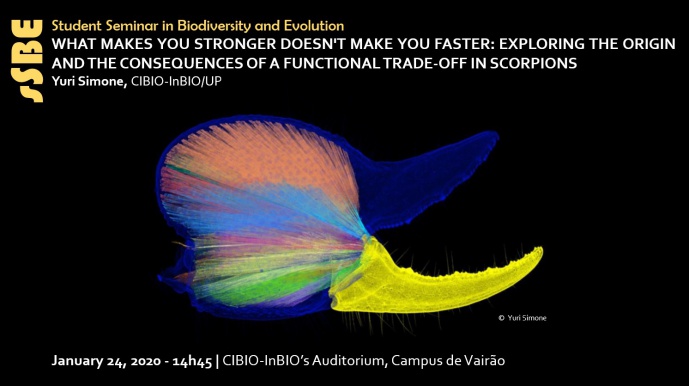What makes you stronger doesn't make you faster: exploring the origin and the consequences of a functional trade-off in scorpions

STUDENT SEMINAR IN BIODIVERSITY AND EVOLUTION
In this seminar, I am going to explain how I will combine functional morphology, NGS metabarcoding and functional ecology to assess if scorpions have different diet according to the shape of the pincers (chelae) they bear. A functional trade-off occurs when the same body structure is under conflicting evolutionary pressures, resulting in sub-optimal adaptation to perform different tasks. By imposing limits on evolution, functional trade-offs are important drivers of phenotypic variability. Scorpions are an order of terrestrial arachnids including around 2500 species inhabiting all the continents except Antarctica. Even if their body plan remained unaltered across millions of years of evolution, this doesn’t mean that scorpions all look the same. Major differences across families rely in their chela shape. Chelae vary from robust short-fingered to extremely elongated tweezer-like shapes and are used for prey capture and incapacitation, defense from predators, sensing the environment and mating. Nowadays, the reason of this chela diversity is still unknown. I discovered that a trade-off exists between chela closing speed and force with the slender, long fingered species being fast but weak, while robust, short fingered species being stronger but slower. The objective of my PhD thesis is to analyze how this functional trade-off may affect the diet of scorpions. To do so, firstly I will study the physiology and the architecture of the muscles responsible of the chela closing in a comparative and evolutionary framework. Then, the expression of muscle-related genes will be explored analyzing the chela transcriptomes from different species. Finally, a metabarcoding approach will be used to identify the gut content in scorpion’s species presenting contrasting chela shape.
Yuri Simone got his master’s degree in Evolutionary Biology in 2016 at the Ferrara University (Italy) with a thesis on the closing speed of scorpion chelae (pincers). In this thesis, Yuri explored the biomechanics of this muscle lever system, analyzing in an evolutionary framework, both morphology and performance. He is also interested in how morphology can affect behavior using scorpions as model organisms. In 2016 Yuri has been involved in a project related to scorpion predatory behavior at the Instituto de Investigaciones Biológicas Clemente Estable (IIBCE) in Montevideo (Uruguay) and is currently collaborating with Grupo de Investigación BEA de la Corporación Huiltur (Ibagué, Colombia) on biomechanical analysis of the predator-prey interaction in scorpions and spiders. Currently, he is developing his PhD thesis in the Scorpion Lab at CIBIO-InBIO. The aim of his thesis is to relate scorpion chela evolution with diet to see if scorpions endowed with different shapes of chelae are also feeding on different prey.
[Host: Arie van der Meijden, Phenotypic Evolution]